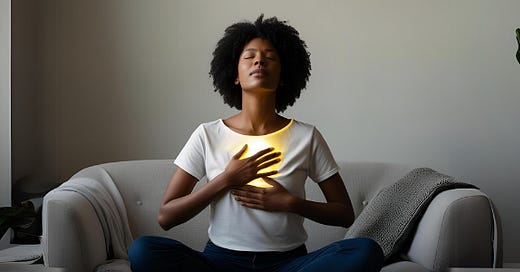Your 2-Minute Stress Reset: The Power of Conscious Breathing
Pause stress before it leads to burnout or other health issues.
Years ago, a psychiatrist prescribed me Abilify. One of its most common side effects is akathisia (experiencing a strong urge to move)—more commonly referred to as restless leg syndrome.
I waived away the doctor’s warning about its potential for RLS, naively thinking, “That’s just a made-up condition helping Big Pharma sell more meds. Even if it is real, though, what’s the worst that could happen? I might feel the need to move my legs?”
I was in for one hell of an awakening.
A few hours after taking my first dose the following morning, my body felt activated—like it was prepared to enter ‘emergency mode’ at any moment, which persisted until I fell asleep that evening. A little concerning, but nothing terribly out of the ordinary.
But sometime around midnight, a bone-deep surge of electricity jolted through my body. I gasped awake, shot straight up in bed, and threw the covers toward the footboard.
I felt like I was trapped inside my own body. Claustrophobia consumed me.
I swung my legs to the edge of the bed, stood up, and peeled off what few clothes I was wearing. My muscles were on autopilot: I began pacing, lapping the room, simultaneously running from and catching myself. It felt like I was crammed inside an invisible box, with my chin pinned to my chest, so I tilted my head back as far as I could and took a giant gulp of air.
Full. Blown. Terror.
Escape was impossible, so to maintain my sanity, I continued pacing while my meditation autopilot kicked into gear: breathing in through my nose, exhaling out through my mouth, and counting my breaths to four.
Pace and breathe. One.
Pace and breathe. Two…
More than an hour later, once I’d finally “crawled out of” my internal confinement and the claustrophobia had passed, I was utterly spent. So, I flopped back into bed and fell fast asleep, only to reexperience the hellscape a couple of hours later.
Pace and breathe. Pace and breathe.
After suffering through this for the next several nights, my sleep-deprived delirium eventually triggered a depressive crisis that landed me in a behavioral center. Needless to say, I stopped taking the medication—but not before learning that the psychiatrist prescribed me double the recommended introductory dose.
Not the happy ending you expected?
The situation could have been a whole lot worse.
Had I not practiced meditative breathing, I believe the terror I experienced could have caused a break from reality and irrational—and potentially self-harming—behavior.
Granted, I admit that I often talk about my (sometimes extreme) examples of mindfulness in action to drive home a point.
However, the reality is that whether it’s everyday inconveniences or full-blown crises, conscious breathing can help us calm down in the middle of stressful moments. And with repeated action, we can reduce our physical responses to chronic stress that—if left unabated—can lead to burnout or other health issues.
Plus, the good news is that you don’t have to meditate for years to experience the benefits of conscious breathing! In fact, by the time you’re finished reading this newsletter, you’ll be fully equipped to find your own peace amidst life’s storms.
Why is Conscious Breathing So Effective for Reducing Stress?
In the scenario above, my brain didn’t recognize that I wasn’t really trapped inside a box. Therefore, it tried protecting me by activating my body’s stress response and preparing it to “fight,” “freeze,” or “flee.” This included increasing my heart rate, speeding up my breathing, tightening my muscles, and flooding my body with the hormone cortisol.
Similarly, our bodies cannot differentiate between “real” threats worthy of stress responses (those threatening our lives, for example) and “false” threats common in modern life, such as your boss constantly breathing down your neck.
In either instance, the body’s response is the same: release cortisol. And overexposure to this hormone leads to:
Poor sleep
High blood pressure
Abdominal weight gain
Increased risk of Type 2 diabetes
Osteoporosis (weak bones)
The solution? ‘Tricking’ your body into doing the opposite of stressing out: chilling out. And it all comes down to paying attention to your breath.
When you’re stressed, you unconsciously take rapid, shallow breaths using your upper chest and shoulders. This maintains your body’s fight, flight, or freeze response and perpetuates feelings of anxiety.
Instead, conscious breathing activates your parasympathetic nervous system, which tells your body that it doesn’t need to maintain a stress response. This can quickly:
Increase a sense of calm and well-being
Decrease feelings of anxiety and depression
Stabilize blood pressure
Reduce heart rate
Balance oxygen/carbon dioxide levels in the blood
Together, when practiced frequently to combat stress, conscious breathing techniques can help improve your overall mental health and well-being. You can also learn them easily, practice them anytime and anywhere, and don’t need any special equipment.
3 Breathing Techniques for Quickly Reducing Stress
While deep breathing may work well for pain, pursed lips for those with COPD, and box breathing for PTSD, each of the techniques below can equally help reduce your stress response.
Try these out and see which ones work best for your specific needs. They each take two minutes or less.
As you grow in your mindfulness practice and improve your conscious breathing skill set, you can explore different aspects of what you experience (e.g., sensations, emotions, etc.) with curiosity.
But for now, just breathe.
Deep Breathing
The basic breathing technique for overcoming stress and anxiety.
Sit in a comfortable position. If appropriate, you can lie on your back.
Breathe in through your nose, allowing your stomach to fill with air, and exhale through your nose.
As you breathe in, keep one hand on your belly, feeling it rise and fall. Keep the other hand on your chest.
Repeat with three deep breaths, feeling your belly rise and fall each time.
Pursed Lips Breathing
Similar to deep breathing, but you’ll purse your lips upon exhaling.
Sit in a comfortable position.
Breathe normally in through your nose for two seconds. Keep your hand on your stomach, feeling it rise.
Purse/pucker your lips like you’re drinking through a straw or about to blow out a candle.
With your lips still pursed, exhale slowly for four seconds, keeping your hand on your belly and feeling it fall.
Continue for two more breaths.
Box Breathing
Uses the same technique as deep breathing, but each part lasts four seconds.
Sit in a comfortable position.
Slowly exhale all the air from your lungs for a count of four.
Slowly inhale through your nose for a count of four.
Hold your breath for a count of four.
Slowly exhale all the air from your lungs for a count of four.
Repeat.
Breathe In, Stress Out
These three simple breathing techniques boost calmness in less time than heating up your microwave burrito. And unlike my Abilify adventure, they come with zero scary side effects.
Remember, you don't need to be a meditation guru to practice conscious breathing, and just a few minutes can help you combat stress.
Whether you're dealing with restless legs or restless bosses, give your stressed-out body the message: "Relax, there are no saber-toothed tigers here. It’s just my inbox."








Box breathing is one of the best things I have learned in my entire life.
I practice conscious breathing quite a bit. I tend to feel anxious quite a bit out of nowhere & my breath brings me back into my body & away from the things in my head that haven’t happened yet 🙃 Usually it’s just deep belly breaths for me but I have been practicing more box breathing lately.